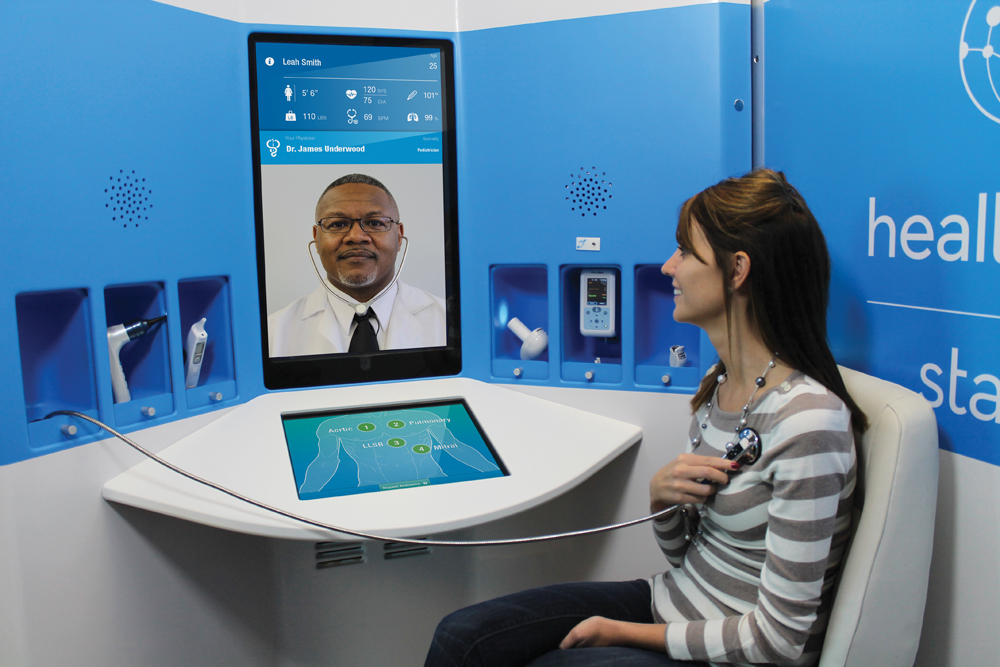The HealthSpot station is an 8x5-foot, ADA-compliant mobile kiosk that lets patients access a network of board-certified physicians through interactive videoconferencing and medical devices, such as stethoscopes, scanners, and thermometers. From that information, the remote doctors can make diagnoses and prescribe advice and medicine.
“We’re bringing the doctor to the patient,” says Steve Cashman, CEO and Founder of Dublin, Ohio-based HealthSpot, which launched its first station at the Consumer Electronics Show last December.
As of mid-October, about a dozen HealthSpots were in use. Eight healthcare systems in Minnesota, Miami, San Diego, and Ohio—including the prestigious Cleveland Clinic—were making caregivers available. Customers can be treated for common health conditions—colds and flu, rashes and skin conditions, eye conditions, earaches, and seasonal allergies.
On November 10, pharmacy chain Rite Aid announced that it had entered into an agreement with HealthSpot to install stations at select Rite Aid locations in the Akron/Canton, Cleveland, and Dayton/Springfield markets in Ohio.
The HealthSpot station was designed by Cleveland-based architectural firm Nottingham Spirk. Bill Nottingham, a Principal, says the station had to be portable, but not so small as to feel claustrophobic. An arched ceiling gives the pod some breathing room
Ohio-based Commercial Vehicle Group, a manufacturer of truck cabs, makes the stations. The units are shipped in pieces and reassembled on site. HealthSpot is providing the units to client locations for a one-time implementation fee to cover the installation, plus a monthly maintenance and licensing fee. Cashman estimates the stations are profitable when they handle at least six patients a day.
Cashman says he plans to place another 100 HealthSpots into the market in early 2015. He says he envisions them being installed on college campuses, in retail malls, and in assisted living facilities.
Read about more innovations from BD+C's 2014 Great Solutions Report
Related Stories
| Jun 30, 2014
Narrow San Francisco lots to be developed into micro-units
As a solution to San Francisco’s density and low housing supply compared to demand, local firms Build Inc. and Macy Architecture each are to build micro-unit housing in a small parcel of land in Hayes Valley.
| Jun 30, 2014
Arup's vision of the future of rail: driverless trains, maintenance drones, and automatic freight delivery
In its Future of Rail 2050 report, Arup reveals a vision of the future of rail travel in light of trends such as urban population growth, climate change, and emerging technologies.
| Jun 30, 2014
4 design concepts that remake the urban farmer's market
The American Institute of Architects held a competition to solve the farmer's markets' biggest design dilemma: lightweight, bland canopies that although convenient, does not protect much from the elements.
| Jun 30, 2014
Harvard releases the State of the Nation’s Housing 2014
Although the housing industry saw notable increases in construction, home prices, and sales in 2013, household growth has yet to fully recover from the effects of the recession, according to a new Harvard University report.
| Jun 30, 2014
OMA's The Interlace honored as one of the world's most 'community-friendly' high-rises
The 1,040-unit apartment complex in Singapore has won the inaugural Urban Habitat award from the Council on Tall Buildings and Urban Habitat, which highlights projects that demonstrate a positive contribution to the surrounding environment.
| Jun 30, 2014
Work starts on Jean Nouvel-designed European Patent Office in the Netherlands [slideshow]
With around 80,000 sm and a budget of €205 million self-financed by the EPO, the complex will be one of the biggest office construction sites ever in the Netherlands.
| Jun 30, 2014
Growth of crowdfunding, public-private partnerships among top trends in architecture marketplace
A new report by the American Institute of Architects highlights several emerging trends in the architecture marketplace, including the growth of the P3 project delivery model and designing for health.
| Jun 30, 2014
Report recommends making infrastructure upgrades a cabinet-level priority
The ASCE estimates that $3.6 trillion must be invested by 2020 to make critically needed upgrades and expansions of national infrastructure—and avoid trillions of dollars in lost business sales, exports, disposable income, and GDP.
| Jun 30, 2014
Gen X, not Baby Boomers, spending the most money on homes [infographic]
It turns out that Generation X, who have the highest incomes of the three generations surveyed, are paying the highest home payments and tend to have the largest households.
| Jun 30, 2014
Zaha Hadid's Iraq Parliament complex design marred with controversy
Zaha Hadid's design for the Iraq Parliament was selected, despite placing third in the original RIBA-organized competition.

















